Traditional German Spaetzle Recipe
This post may contain affiliate links. See my disclosure policy.
One of Germany’s most popular and beloved foods, here is a fool-proof and authentic German Spaetzle recipe, just the way my Mutti and Oma made it! Perfect texture and perfect flavor, these are just like you know and love them from the Swabia region of Southern Germany where they originated!
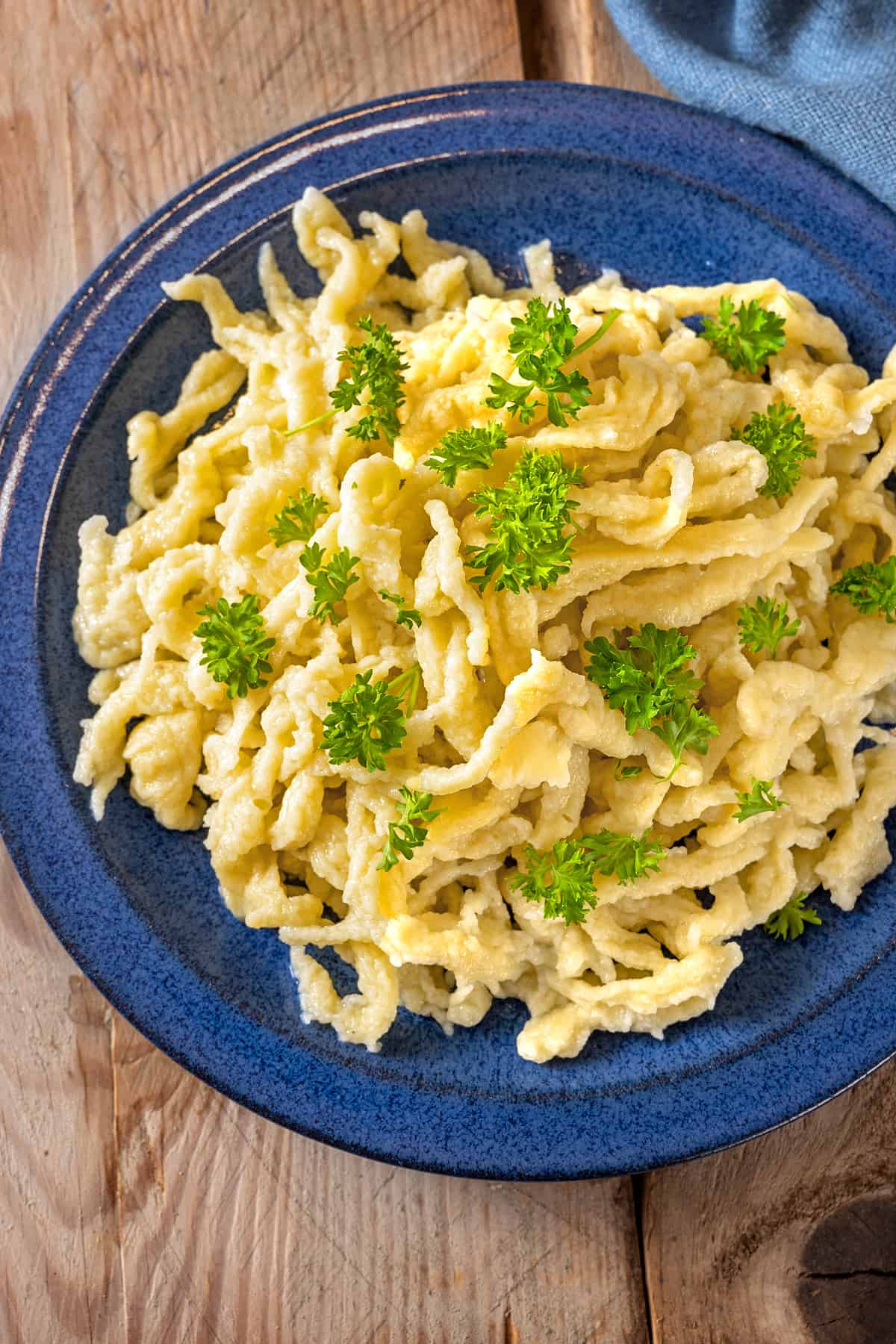
What is Spaetzle?
One of the most beloved foods in Germany that tourists go home talking about is Spaetzle, the famous German egg noodles from the Baden-Württemberg region of southwest Germany. This area is also known as Schwabenland, or Swabia. I grew up in Stuttgart, the capital of Baden-Württemberg, watching my Mom and Oma make Spätzle – I learned from the best!
Swabia is home to some of Germany’s best food (many, including myself, will argue it’s home to the best food in all of Germany). And that’s saying a lot because every region of Germany has amazing food. Swabia is known for its soups, sauces, meats, wursts, and salads, to name a few. It’s also home to some unique varieties of pasta including Spätzle, Schupfnudeln and Maultaschen.
Today we’re featuring Spätzle, a Swabian specialty that is also enjoyed in Austria and Switzerland. Spaetzle is a special type of egg noodle that is enjoyed with sauces and gravies as well as incorporated into a variety of different dishes. One example is Käsespätzle (a cheese spatzle casserole with crispy fried onions). Where did the name “Spätzle” originate? It comes from the German word Spatzen, meaning “little sparrows”, because that’s what they were thought to resemble when they were traditionally made by hand.
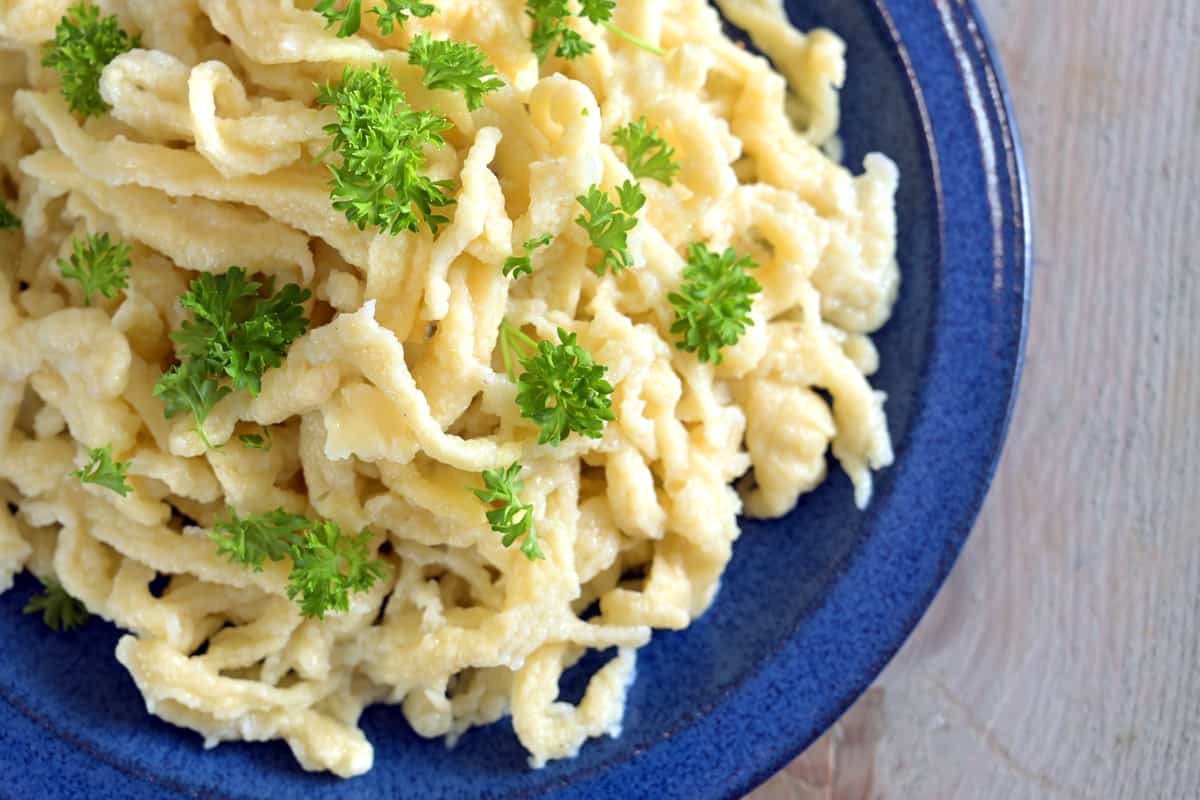
Spaetzle Ingredients
Spaetzle is a type of pasta and as such is made with a very few, simple ingredients that you’ll already have in your pantry. Here’s what you need:
- All-purpose flour: this creates a tender Spaetzle that still has a nice chewy texture.
- Eggs: these add richness and contribute to texture.
- Milk or water: You can use either but I prefer milk as it adds richness.
- Salt: enhances the flavor.
- Nutmeg: this is optional and is not traditional, though many German cooks today like to add it for flavor.
Spaetzle Recipe
Let’s get started!
This spaetzle recipe uses a stand mixer to knead/mix the dough. This is actually the first time I’ve made it that way. I’ve always done it by hand (you “knead” it by vigorously whipping it in a bowl with a spoon – over and over and over for around 20 minutes. It’s a lot of work!) I decided to to try it with a stand mixer instead and it turned every bit as good – and it sure saves a lot of muscle strain!
Add the flour and salt in the bowl of a stand mixer. Stir to combine. Crack four eggs into a bowl and whisk to combine. Make a well in the center of the flour and add the eggs. Add the milk or water and with the paddle attachment (I initially tried the dough hook and it didn’t work well), knead/mix the dough on the “2” setting for about 10 minutes to get a cohesive batter. Add more flour if the mixture is too runny, or more milk if it is too stiff.
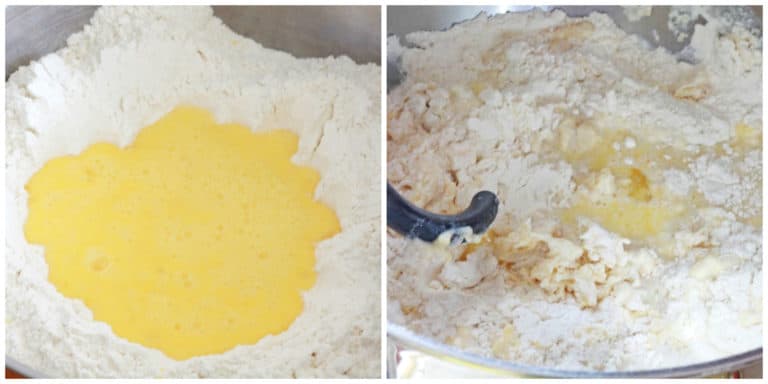
Pro Tip: How to Know When the Spätzle Batter is Ready
The batter is done when “bubbles” begin to form. After about 10 minutes of beating, use a wooden spoon and scoop and pull to stretch the batter; if bubbly holes appear, the dough is done. If not, continue “kneading” with the mixer for another minute or two, repeating the “test” process. See the bubble hole below?
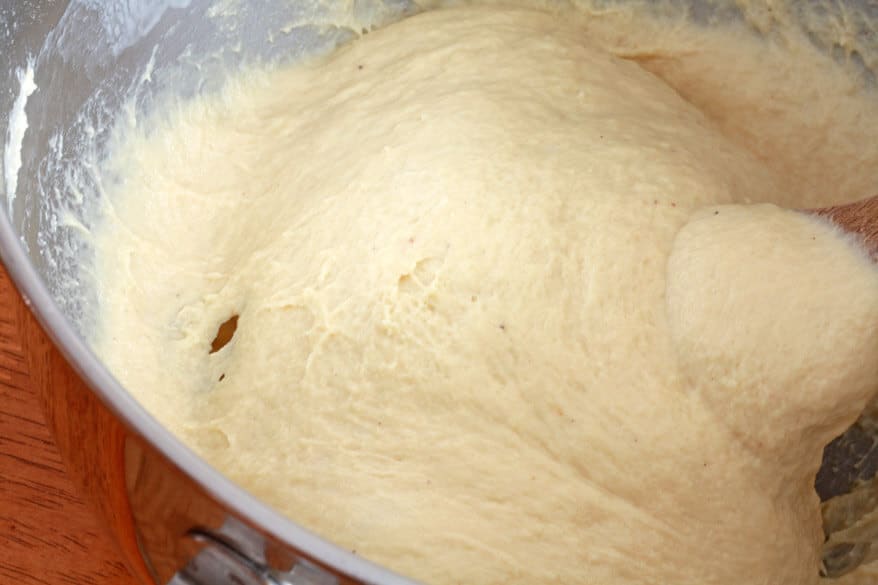
When those bubbly holes start appearing you know your batter is done.
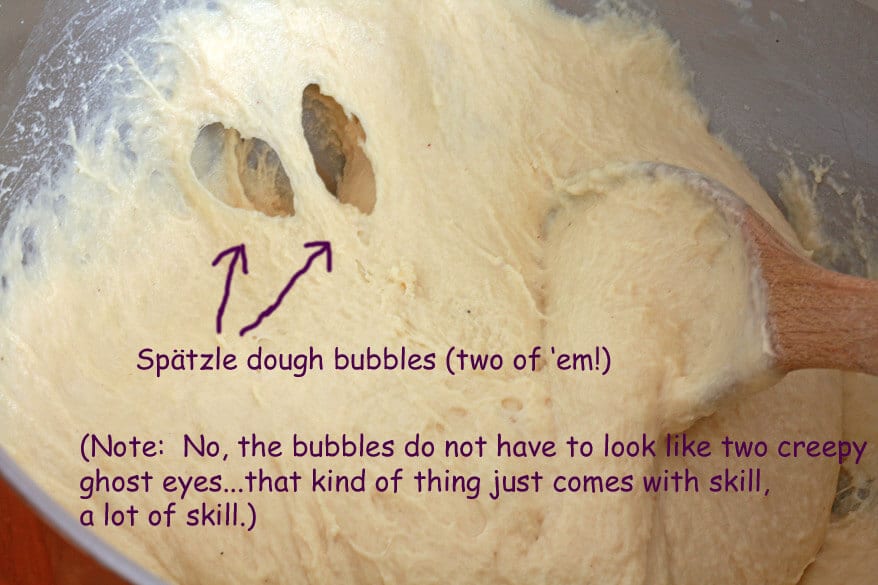
What Is the Best Spätzle Maker?
Now that the batter is read it’s time to make the Spätzle. And when it comes to the Spaetzle maker, there are a few options to choose from. Traditionally, Spätzle was made by hand using a Spätzlebrett, or Spaetzle board. You would rub a slab of dough out onto a wetted board and use a pastry cutter or long sharp knife to quickly cut off strands of the dough into simmering water. Swabian women of previous generations were highly skilled at this and could do it so fast it would make you dizzy to watch. Nowadays most Germans use a Spätzle maker (and even more just buy it ready made at the store. It’s the “convenience generation”).
Besides the traditional Spätzle board there are a few different kinds of Spätzle makers out there that you can find online:
- Spätzle Press (below left): That is my Spaetzle maker that I brought with me from Germany when I moved to the U.S. and it’s awesome. This kind is pricey but it will last a lifetime. It’s called the Original Kull Spätzle Maker and is made in Germany. It’s built like a tank and will become a family heirloom you can pass down for generations. Another brand that is much cheaper and is also made in Germany is this Westmark Spätzle Maker. These Spätzle presses can also be used as potato ricers.
- Spätzle Scraper (below right): Another option is the Küchenprofi Spätzle Lid & Scraper. I’ve used this one as well with good results and it’s much cheaper. It produces a shorter, stubbier spatzle noodle. Alternatively you can also use a metal steamer because it’s similarly constructed with large holes. You place some of the dough in the steamer over the simmering water and scrape the dough through the holes.
- Spätzle Plane: A third option is the Küchenprofi Spätzle Plane with Pusher, which is my least favorite as it can be a little clumsy, messy, and more difficult to work with but I know people who use it.
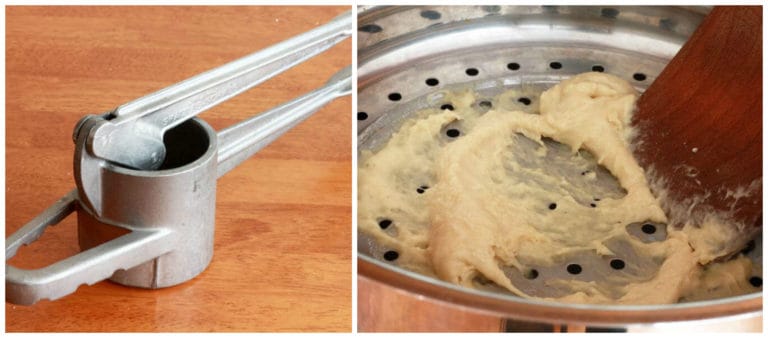
My personal favorite is the Spätzle press and that’s what I’m using in the pictures below. Place the Spaetzle maker over a pot of lightly salted simmering water and scoop some dough into it.
Press the Spätzle maker down to squeeze the Spätzle noodles out into the simmering water. Simmer the Spätzle for about 2-3 minutes or until they float to the top.

Using a slotted spoon, transfer the Spätzle to a colander and then immediately put them in a bowl of very cold water. This helps them firm up to the desired consistency.
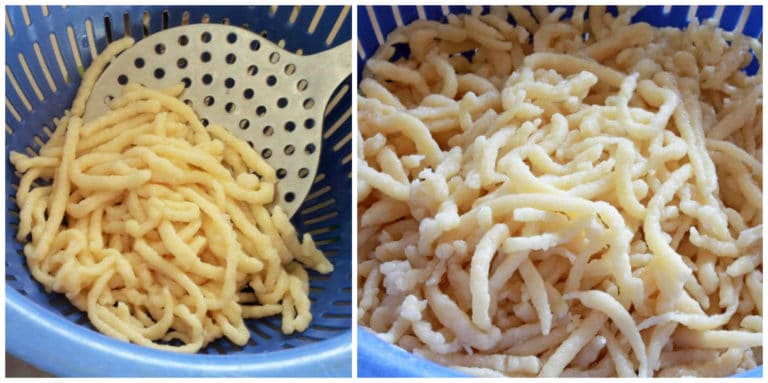
Drain the Spätzle again and toss with a little oil or melted butter to keep them from sticking.
Spätzle will keep in the fridge for at least a couple of days and then heated to serve. Melt some butter in a pan and toss the Spaetzle in it to warm through.
Storage & Freezing
Spaetzle can be made in advance, cooled, and stored in a covered container in the fridge where it will keep for 3-4 days. To reheat it you can microwave it in a microwave-safe container or, my favorite way, is to melt some butter in a large skillet, add the Spätzle and heat through. Spaetzle also freezes well for up 3 months: put it in a freezer-safe container and let it thaw overnight in the fridge. It can be reheated in the microwave in a covered container so that it doesn’t dry out, or you can melt some butter in a pan and toss the Spaetzle in it until warmed through.
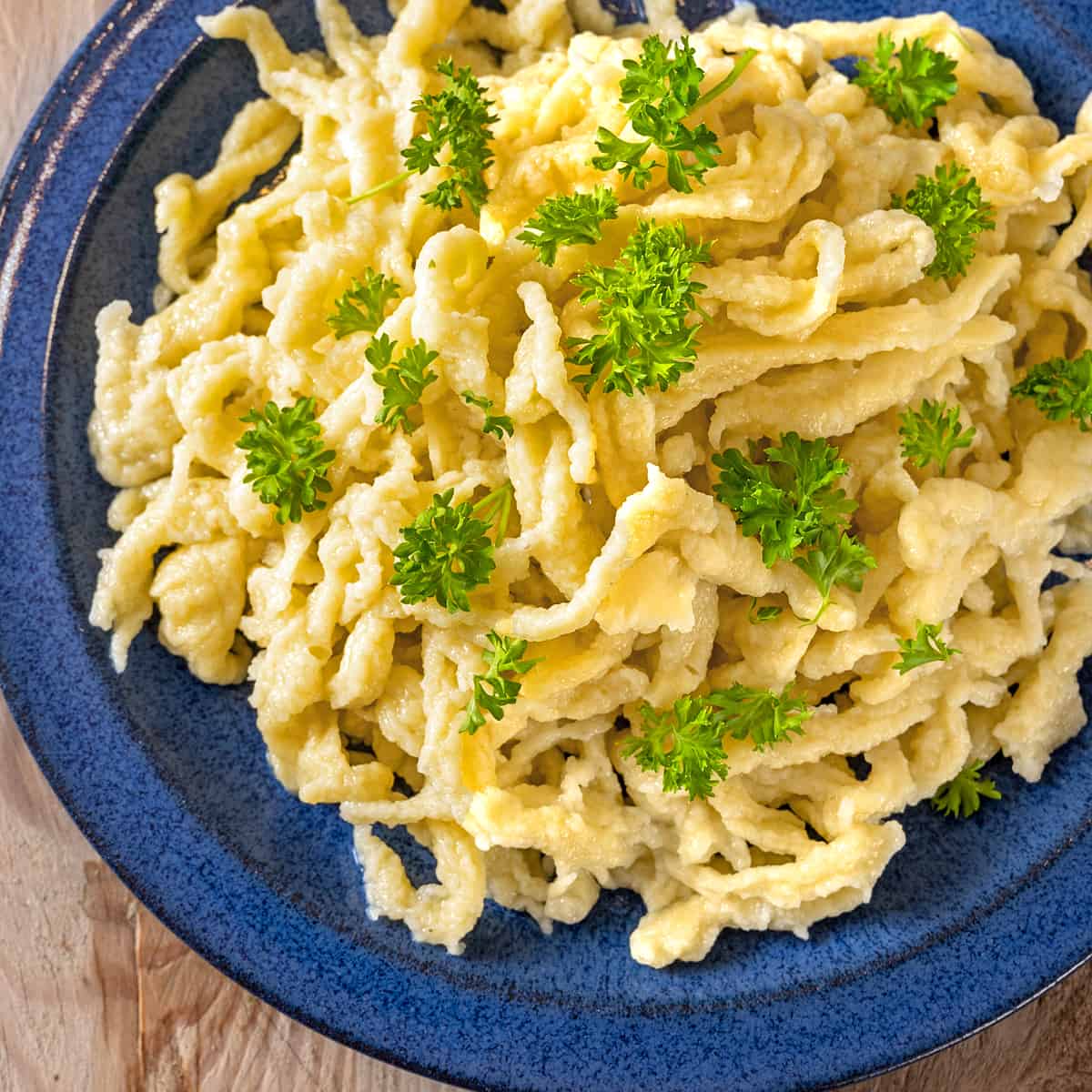
What to Serve with Spaetzle
Spaetzle is very versatile and can be served a variety of ways. Here are a ways to serve spaetzle:
- Buttered Spätzle: This is one of the simplest and most traditional ways to serve spaetzle. After boiling and draining the cooked spaetzle, toss them with melted butter and sprinkle with chopped parsley.
- German Cheese Spaetzle (Käsespätzle): Another Swabian classic and personal favorite, try my recipe for Käsespätzle (pictured below).
- With Sauces and Gravies: Spaetzle can be served with any sauce or gravy, like my favorite German Rahm Sauce, Onion Gravy, or Mushroom Gravy. Serve it with my classic German Goulash, Geschnetzeltes or Königsberger Klopse.
- With Meat Dishes: Spaetzle is the perfect choice to serve with any saucy meat dish like Jagerschnitzel, Rouladen, Sauerbraten, Pot Roast and Tri Tip Roast. It can also accompany your Schweinshaxe and Frikadellen.
- Pasta Salads: For a variation on traditional pasta salad, toss the spaetzle with fresh vegetables, herbs, a vinaigrette, and some diced cheese and ham.
- In Soups: In some regions, spaetzle is added to soups, much like dumplings. Drop small portions of spaetzle dough directly into simmering soup and let them cook until they float to the surface as in this Gaisburger Marsch and German Pea Soup.
Guten Appetit!
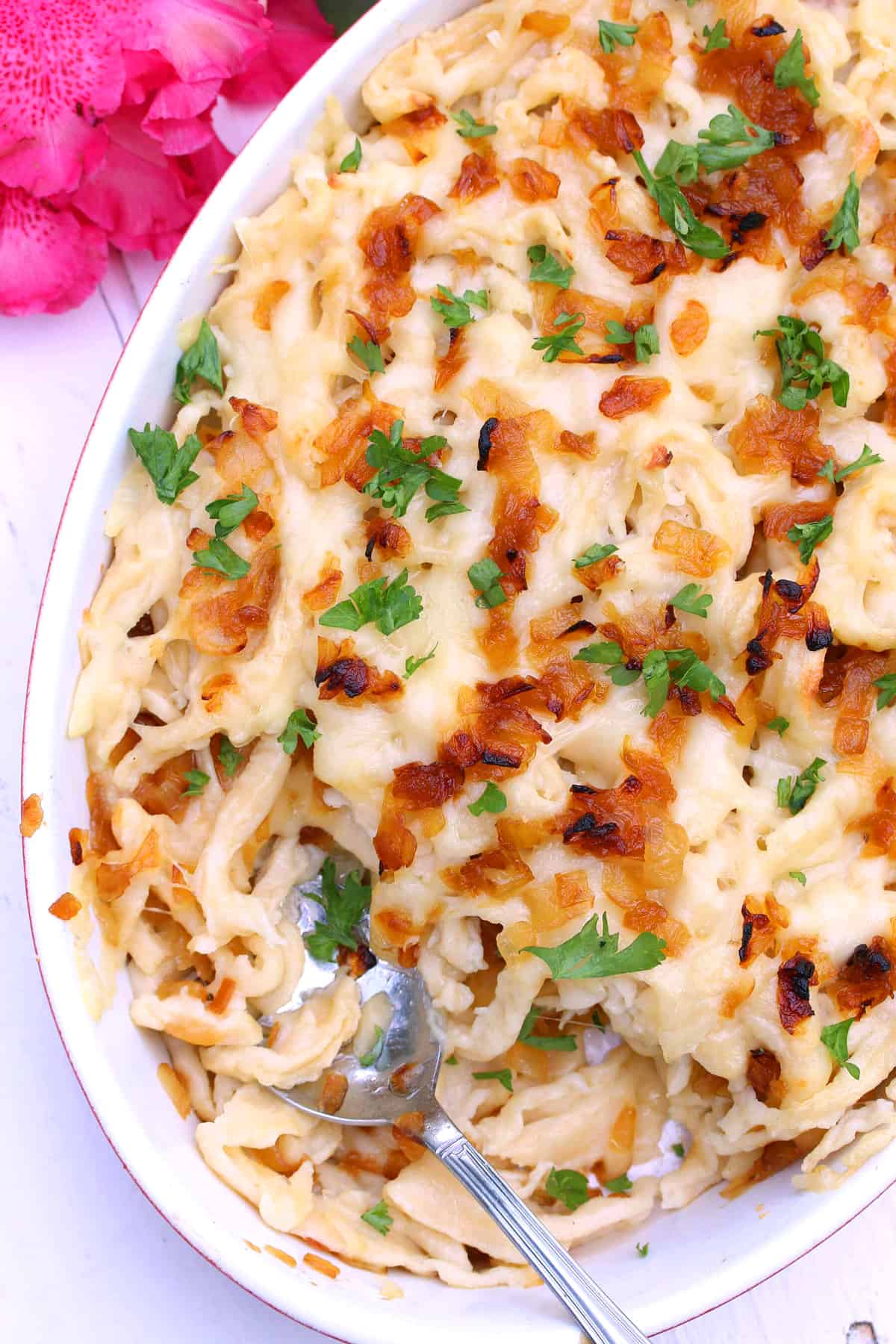
For more favorite traditional German dishes be sure to try my:
- Kaesespaetzle
- Rouladen
- Sauerbraten
- German Goulash
- Maultaschen
- Schnitzel
- Bread Dumplings
- German Potato Dumplings
- Zwiebelkuchen
- German Bread (Vollkornbrot)
- Bratwurst
- Currywurst
- German Potato Salad
- Rotkohl
Save This Recipe
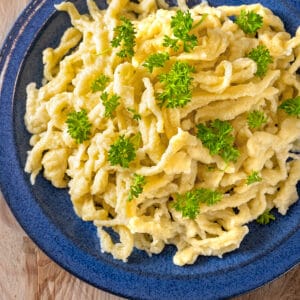
Traditional German Spaetzle Recipe
Equipment
Ingredients
- 2 cups all-purpose flour (you can also use whole wheat flour)
- 1 1/2 teaspoons salt
- 1/8 teaspoon freshly ground nutmeg , optional (not traditional but adds a nice flavor)
- 4 large eggs
- 1/2 cup milk or water + more as needed (milk produces a richer Spaetzle) (**add more flour if the dough is too runny, add more milk or water if it's too stiff)
- butter for serving
Instructions
- The Spätzle batter can be mixed by hand or by using a stand mixer which is much easier. Add the flour, salt and nutmeg (if using) to the bowl of a stand mixer. Stir to combine. Crack the eggs into a small bowl and whisk them. Make a well in the center of the flour mixture and pour the eggs in it. Add the milk (start with using slightly less and add more as needed). Attach a paddle attachment to the stand mixer and "knead" the dough for about 10 minutes or until bubbles appear (see pictured instructions for details). After 10 minutes or so of beating, use a wooden spoon to scoop and pull the dough. If bubbles/holes appear, the dough is done
- Bring at least 2 quarts of lightly salted water to a boil, then reduce to a simmer. Using a Spätzle maker of your choice (I use and prefer the Spätzle press), press the noodles into the simmering water and cook for about 2-3 minutes, or until the noodles float to the top. Use a slotted spoon to transfer the noodles to a colander to drain the hot water and then to large bowl of ice water (this firms them up for a better/chewier texture). After a minute or two transfer them to a colander to drain completely. Before serving, warm them through in a skillet with some melted butter.
- Make Ahead: The Spaetzle can be stored in the fridge for at least a couple of days and then reheated. Melt some butter in a large skillet and toss the Spätzle in it to heat through. Alternatively they can be microwaved in a covered dish.
Notes
Nutrition
Originally published on The Daring Gourmet on August 3, 2013



















Thanks for that Kim, I would like to conquer the art of the machine! However today we will have Laugen Praetzlen, yes i have conquered that art. I have baked my own bread now for the last 50 Years as I lived in your name sake area of W.A The Kimberly – in the most remote places there – so no bakeries or shops that cater for the Schwaebisch palet. So you learn to garden and bake cook etc.
That’s wonderful, Margarete. We have everything easily accessible here (even a German deli) but we still have a garden each year and I love to do canning, bake my own bread, etc. Nothing beats homemade bread. I’d love to try your Laugenbrezel! Greetings to The Kimberly, Australia! :)
I am from Heidenheim at rhe end of the Swabian Alps so grew up on spaetzle I have lived in Australia for the last sixty years and still make spaetzle on a board. However, I recently visited family in Goeppingen and she used a potatoe ricer and they came out quickly and perfect. I thought now that I am old I could well do spaetzle by machine but O dear I can’t conquer the art? if there is an art to it? they come out in a lumpy mess and I do not want to go back to the board, I would like to know what I am doing wrong?
Small world, Margarete, my Oma and Opa lived in Göppingen for 40+ years. Yes, Spätzle can be frustrating. The Spätzle maker has a groove in it that allows you to set it on the pot of simmering water so that as you squeeze the dough through the strands don’t jiggle and stick together as much. Wait for the strands to dangle down a ways and then cut them with a knife. They will initially stick together at the ends but as soon as they hit the simmering water they’ll separate. Once they hit the water you can also give the water a little stir to help separate them. The other really important factor is to make sure you’re “kneading” the dough long enough – getting to the stage where those bubbles start forming is essential. I don’t blame you for not wanting to go back to the board! And there’s no need to do that – give it another try with the machine, you’ll conquer it yet!
Not sure we did the dough correctly, but it tastes good. And, we used a beef jerkey caulking gun — sprayed oil on it all over, and then used a scissors to snip the ends. Worked great!
Hahahaha, love it!! You definitely win the prize for originality! :) Glad you enjoyed it, MNCoolio!
Hi -great recipe and true to tradition. My only comment for those who have not made spatzle before is that you should try the old fashioned way of a scraper and board. It takes a bit of time to learn the trick and you’ll find your first few attempts may result in some odd sized and odd shaped noodles, but the thing is, because the dough is not compressed like it is thru the spatzle makers the noodles have a much lighter texture and more delicate consistency. It is much more time consuming to make them this way, but they turn out so much nicer. My family has stuck to making them this way for generations, (both my parents are from Germany; I am a first generation Canadian.)
Thanks for your comment, Tolly. I agree, I too prefer the shape and texture of Spätzle made with the Spätzlebrett (Spätzle board). I like the non-uniform shapes and sizes. The fact is though most people would have a hard time telling the difference in method used. If the Spätzle press were able to make the odd shapes and sizes like the Brett does and you had a dish of each side by side, most likely only a Spätzle purist would be able to tell the difference. Perhaps that’s what we are, Tolly :) When I the have time to make Spätzle using the board I do, but that isn’t often and these days I use the press more than anything. Psychologically it’s not quite as gratifying, but it’s still homemade Spätzle and nothing can beat it!
Grüß Gott. und Danke for the great recipe.
Spätzle is customarily made with “type 405 mehl” (flour) which I have never found Stateside. A close equivalent can obtained mixing AP flour with cake flour in a 2:1 ratio.
I made a batch with this edit… great results.
Hi Jim, it’s definitely true that German flour is different, and there are so many different types of flours in Germany, which I really miss. It’s a bit of an ongoing debate in Swabia which flour is best for Spätzle and you’ll find Swabians of varying opinions on that point. In practically every grocery store there you can actually find “Spätzlemehl” (Spätzle flour) which is specially made for making Spätzle and is different than type 405. Spätzle is supposed to have “Biss” (be slightly firm and chewy) and some argue that 405 doesn’t render the ideal texture of traditional Spätzle (ie, too soft). The fact is though that Spätzlemehl is a contemporary invention and housewives of old certainly wouldn’t have found it in stores. What many of them did was add a bit of Griess (semolina) to the batter to give it more “grip” or firmness. If you do go with the 2:1 ratio alteration you’ll most likely need to reduce the amount of water a bit or the Spätzle will be really soft. Thanks for making this recipe, Jim, and I’m thrilled you enjoyed it!
Please may I ask what’s the best flour to use in making this dish here in the States then?
Hi Jennifer, here in the U.S. I just use regular all-purpose flour and the results are still great.
Thank you. I’m going to try and make it
Based on the reasearch I’ve done, proper German “spätzlemehl” is a special product – on one hand, it has the same protein content (10-11% as all-purpose flour), but what’s different is that it’s a more coarse grind – somewhere between regular and semolina flour, I think. It’s difficult to reproduce that with flours in the US or UK – if you do a blend of semolina and all-purpose flour, you’ll end up with something with a higher protein content than typical German spätzlemehl.
Slightly confused. Your recipe makes thick bread type dough. I recently saw a recipe (which started this journey) where the chief said it should be a runny consistency and if it is too thick to add more water. Her recipe was for a Ricotta Thyme Spaetzle (Five ingredients fix). Does the traditional recipe require thicker dough? And does this make a longer noodle? Thanks for the help as I would love to try any one of these Spaetzle dishes.
Hi Andrew! Yes, it should be a pretty thick dough and it requires effort, and muscle strength (!) to push it through the Spätzle press. In olden days they used a Spätzle Brett, a wooden board, and would cut the noodles. Spätzle should never by super soft or mushy. They should be fairly firm and springy to the bite. The recipe you mentioned using ricotta is very non-traditional and I would imagine the chef’s instructions are for that recipe alone. As to the length of the noodles, that simply depends on what equipment you use. Some methods yield long noodles, other shorter chubby noodles, and still others very short button-like noodles. All just personal preference.
Can these noodles be made and dried to use later? The reason I asked is I bought a package of them that were dried. I can not remember where I bought them but I loved them. I am only one in my home and it was so nice to be able to fix just what I needed at the time.
Hi Bonnie! Yes, dried Spätzle can be purchased in stores throughout Germany just like any pasta and can be found in some specialty stores here, too. The recommended way to store the Spätzle for long-term use is to freeze it. This is how you would freeze it: After making the Spätzle, let it drip in a strainer for several minutes, tossing it to get as much moisture out as possible. Portion out the Spätzle into freezer bags according to how much you want to use at a time. Press as much air out of the bags as possible, starting from the bottom and ending at the top. Seal the bag. Put the bags in the freezer on a flat surface. Store in the freezer for up to six months for optimum taste (I would recommend using it sooner). When ready to use, remove the bag from the freezer and place it in the refrigerator the day before you use it in a recipe. Fry the defrosted Spaetzle in a frying pan.
Hello from Swabia/Germany! ☺
I think, some day I will try to make Spätzle like you make it. It sounds interesting. But to be honest, this is not a traditional Swabian Spätzle recipe. There is no milk and no nutmeg in traditional Swabian Spätzle at all. We use only flour, eggs, water and wheat semolina. That’s how Swabian housewifes and cooks prepare Spätzle for generations.
Maybe you want to try this version some day too?!
Verena
Hallo, Verena, liebe Grüße aus Washington! Thanks for sharing your thoughts about Spätzle. I think we’re both correct. As with anything that’s a “traditional” recipe, there will always be some variations depending on who you talk to and family traditions. Variations can also differ between sub-regions within a region. I’m from Stuttgart, the heart and capital of Swabia, and most of the home cooks I knew, as well as some restaurant chefs I spoke to, use milk and water interchangeably when making Spätzle. I even have some old German recipes from the 1950’s that call for milk. Whether using milk or water, both are traditional and simply come down to personal preference. I’ve made it both ways – many times – and both ways produce great results. Milk produces a richer Spätzle noodle, which is my preference. The small pinch of nutmeg to add a little depth of flavor – again, personal preference. That’s how my Oma and Großoma made it. Also, I do like Spätzle with the Semmelbrösel (wheat semolina), but this recipe is just for the basic Spätzleteig Grundrezept (basic Spätzle dough recipe). I may write another blog post in the future with examples of different ways to serve up Spätzle. I will be featuring Käsespätzle on my blog at some point – another favorite! Danke nochmals, Verena, and I hope you’ll visit frequently! Best, Kimberly
Thx, so gluten wheat flour must be OLD secret like my g’ma made! (?) having disasters w kind of flour. gluten free is a big fail! I drop mine by small spoonful into boil water. egg, flour, water. my Slovenian g’ma receipe.